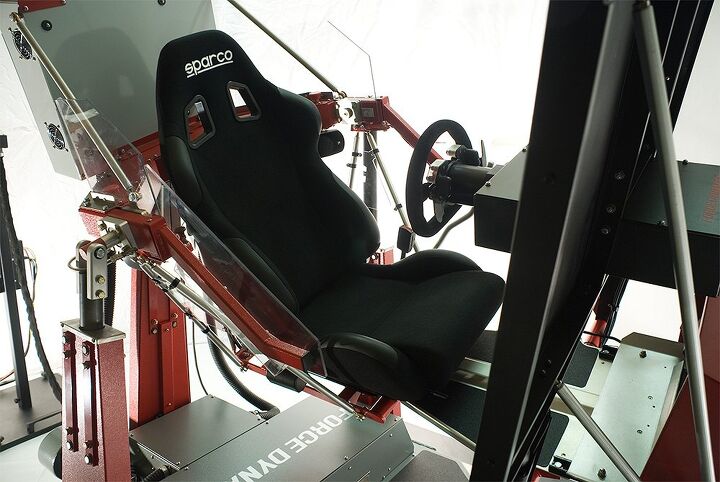TTAC Reader Pits Simulated MX-5 Against the Real Deal [with Video]
My company, Force Dynamics, builds full-motion driving simulators. They work by tilting you as the simulated vehicle corners or accelerates, so your brain is tricked into feeling lateral or longitudinal accelerations.
Sometimes people who watch our machines in action say, “This is moving way too much!” So when we started racing a Mazda Miata in the ChumpCar World Series, I decided to conduct an experiment.
The result: a comparison of the forces you feel while driving a race car with the forces you feel while driving our motion systems. The phone, like your inner ear, can’t tell the difference between being accelerated or tilted. What you see on the phone in each half of the video is what I was feeling in the real car and in the simulator.
How do the two experiences compare? Practicality limits the simulator’s sustained force to about .6 g. Luckily, your perception is enhanced a bit: in the simulator, the force keeping you in the seat gets lower as you tilt, whereas in real life that force is always 1 g, so you feel more “oomph” for a given load in the simulator than you do in real life. There’s also a psychological component. You’re seeing yourself cornering, and you’re getting other secondary cues, too: in the 401cr, your rate of rotation; vibration; sound and fury.
How do the two differ? Well, the real car is easier: your positional awareness is better, and the onset cues are sharper, so it’s easier to read the car on turn-in. Those differences aside, however, I was almost immediately comfortable making the transition to real driving. Shifting, braking, cornering, and handling the car on the limit all made nearly direct transitions to the track; for example, I was immediately comfortable holding the car at small slip angles through long, fast corners, because it behaved exactly like I expected it to.
What this means is while the simulator can’t fully match the sustained accelerations of a real car, the overall feel can be very good, and a high-quality motion platform can help immensely in the transition from simulator to track.
If you have any questions, feel free to ask in the comments.
Submitted by David Wiernicki. You may know him as B&B member PeriSoft in the comments.
More by Ur-Turn
Latest Car Reviews
Read moreLatest Product Reviews
Read moreRecent Comments
- ToolGuy First picture: I realize that opinions vary on the height of modern trucks, but that entry door on the building is 80 inches tall and hits just below the headlights. Does anyone really believe this is reasonable?Second picture: I do not believe that is a good parking spot to be able to access the bed storage. More specifically, how do you plan to unload topsoil with the truck parked like that? Maybe you kids are taller than me.
- ToolGuy The other day I attempted to check the engine oil in one of my old embarrassing vehicles and I guess the red shop towel I used wasn't genuine Snap-on (lots of counterfeits floating around) plus my driveway isn't completely level and long story short, the engine seized 3 minutes later.No more used cars for me, and nothing but dealer service from here on in (the journalists were right).
- Doughboy Wow, Merc knocks it out of the park with their naming convention… again. /s
- Doughboy I’ve seen car bras before, but never car beards. ZZ Top would be proud.
- Bkojote Allright, actual person who knows trucks here, the article gets it a bit wrong.First off, the Maverick is not at all comparable to a Tacoma just because they're both Hybrids. Or lemme be blunt, the butch-est non-hybrid Maverick Tremor is suitable for 2/10 difficulty trails, a Trailhunter is for about 5/10 or maybe 6/10, just about the upper end of any stock vehicle you're buying from the factory. Aside from a Sasquatch Bronco or Rubicon Jeep Wrangler you're looking at something you're towing back if you want more capability (or perhaps something you /wish/ you were towing back.)Now, where the real world difference should play out is on the trail, where a lot of low speed crawling usually saps efficiency, especially when loaded to the gills. Real world MPG from a 4Runner is about 12-13mpg, So if this loaded-with-overlander-catalog Trailhunter is still pulling in the 20's - or even 18-19, that's a massive improvement.


































Comments
Join the conversation
Two words: that is super cool.
Hey guys - I'm the guy from the article there (and the Chump in the car). If anyone has any questions, fire away! As for the ones already asked... yeah, it's more expensive than a Chump Car, though I have to say it's probably not THAT much more than all the costs of a few guys running Chump for a couple of years. As for pricing, think about a 5-series. Not the one with pleather and manual mirrors; the one you'd actually drive. So yeah, it's not super cheap. But like I said, if you take running costs into consideration, it starts to look reasonable again, especially if you're comparing it to something like running SCCA regionals: Good luck pulling that off (in most any class) for under fifty grand a year. And then there's the thing I tell people on YouTube: You can crash a simulator more than once!